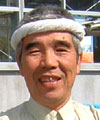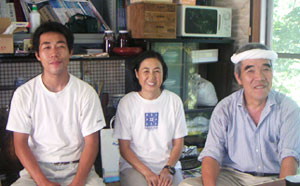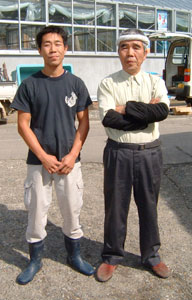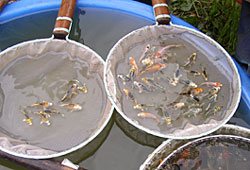
Featured Breeder
Tetsutaro Kataoka (Oya Koi Farm)
|
 |
One of the breeders who, more than anybody else, takes pride in Niigata’s ancient traditions and culture and who insists on handing them down to the next generation precisely because Niigata is the birthplace of Nishikigoi. He and his family enjoy working together to produce beautiful Taisho Sanshoku.
|
 I founded Katasei Koi Farm in 1961 right after I graduated from high school and began a full-time Koi business. Eleven years after that, I changed the farm name to Oya Koi Farm. Furthermore I wanted to pass down Yamakoshi-mura’s tradition to the next generation, so I started raising Tsunotsuki bulls. The tradition of Tsunotsuki*, with a 1000-year history, is obviously longer than that of Nishikgoi and has been assigned as the nation’s significant intangible folk cultural asset. I know I’ll be able to seek out Nishikigoi’s roots in these fighting bulls because I believe that the basis of the foundation of today’s Nishikigoi industry was our local culture: culture that brings down many valuable things through time to the next generation. The bulls originally came to Yamakoshi carrying iron and salt on their backs from as far as the southern part of Iwate Prefecture, but I don’t know the whole background. I have heard that the former owner of Izumiya, Mr. Ichiro Mano, was the last person to transport salt in that way at the time. I founded Katasei Koi Farm in 1961 right after I graduated from high school and began a full-time Koi business. Eleven years after that, I changed the farm name to Oya Koi Farm. Furthermore I wanted to pass down Yamakoshi-mura’s tradition to the next generation, so I started raising Tsunotsuki bulls. The tradition of Tsunotsuki*, with a 1000-year history, is obviously longer than that of Nishikgoi and has been assigned as the nation’s significant intangible folk cultural asset. I know I’ll be able to seek out Nishikigoi’s roots in these fighting bulls because I believe that the basis of the foundation of today’s Nishikigoi industry was our local culture: culture that brings down many valuable things through time to the next generation. The bulls originally came to Yamakoshi carrying iron and salt on their backs from as far as the southern part of Iwate Prefecture, but I don’t know the whole background. I have heard that the former owner of Izumiya, Mr. Ichiro Mano, was the last person to transport salt in that way at the time.
 I mainly produce Taisho Sanshoku but various others, too. “Producing Taisho Sanshoku will make you poor”: it has always been said that producing this variety is a risky job. When expecting a good Koi, you might get a bad one, and on the contrary, a Koi that you thought would turn out terrible might become beautiful. To me, that’s the interesting part of Taisho Sanshoku. Having produced a Koi with deep black sumi and shining hi patterns on a snow white body brings me real pleasure. I mainly produce Taisho Sanshoku but various others, too. “Producing Taisho Sanshoku will make you poor”: it has always been said that producing this variety is a risky job. When expecting a good Koi, you might get a bad one, and on the contrary, a Koi that you thought would turn out terrible might become beautiful. To me, that’s the interesting part of Taisho Sanshoku. Having produced a Koi with deep black sumi and shining hi patterns on a snow white body brings me real pleasure.
All of the Niigata breeders, including myself, suffered major damages from last year’s earthquake. The Koi we wanted to sell were all gone, and we had no ponds even though we wanted to produce them. The earthquake left much too severe traces. And besides the Koi farms, we had to reconstruct our village as well. Can we go back to our normal life? Can we continue the Koi business? Honestly, we were very concerned.
But all of the breeders, myself included, love Nishikigoi. As Koi lovers pursue beautiful Koi, we want to keep producing them no matter what because we love them. The land where we were born and raised is surrounded by mountains. Perhaps we care so much about beautifully swimming Nishikigoi because we are people who depend on the mountains for a living.
From the birth of Nishikigoi until now, traditional Nishikigoi have been beloved by the Japanese. But now they are loved by many people around the world. I strongly hope to hand down Niigata originated Nishikigoi to the next generation. All of the Koi ponds, up until now, were located in the mountains, but we temporarily had to secure space in the plain fields after the earthquake. We realized that it was easier to work there, including things like temperature control. For all I know, many breeders may move their ponds to the plains. I believe that exploring better environment and development it is a very important decision in preserving Niigata’s Nishikigoi. However, even if the job is harder compared to in the plains, Oya Koi Farm’s pride is to stick to our land and mountains and to leave behind Nishikigoi in our time-honored fashion.
 What I want to convey to the Koi lovers is the following: the beauty of Nishikigoi is in their swimming figure. We, as Koishi, produce Nishikigoi, but that beauty is created by nature. What we are doing is returning them to their natural state. In other words, we’re simply providing a product of nature in their true light. I hope you will enjoy our products grow and blossom. There is no 100 percent perfect Koi. We breeders, using experience and sensitivity cultivated over the years, produce healthy and well-balanced Koi, Koi that we like and enjoy ourselves. And will the Koi lovers empathize with our sensitivity? That’s our biggest assignment. What I want to convey to the Koi lovers is the following: the beauty of Nishikigoi is in their swimming figure. We, as Koishi, produce Nishikigoi, but that beauty is created by nature. What we are doing is returning them to their natural state. In other words, we’re simply providing a product of nature in their true light. I hope you will enjoy our products grow and blossom. There is no 100 percent perfect Koi. We breeders, using experience and sensitivity cultivated over the years, produce healthy and well-balanced Koi, Koi that we like and enjoy ourselves. And will the Koi lovers empathize with our sensitivity? That’s our biggest assignment.
 Another point is that Nishikigoi are living creatures. Among tens of thousands of Koi that are born, only 1 in 200 will come to be called a true “Nishikigoi”. From there on, speaking in terms of Taisho Sanshoku, one-tenth of them will be valued as 2-year old Koi, and further on 10% of them will grow into valuable 3-year olds. We breeders always create Nishikigoi with the assumption that “they will grow in a certain direction.” Therefore, we hope you will choose the Koi you like and will enjoy its growth and changes. A great Koi is one that is pleasing and satisfactory to both breeders and Koi lovers. Of course it is wonderful to pursue beauty and perfection in Nishikigoi, but you can choose a Koi “just because you like its face.” That’s a great choice, too. Another point is that Nishikigoi are living creatures. Among tens of thousands of Koi that are born, only 1 in 200 will come to be called a true “Nishikigoi”. From there on, speaking in terms of Taisho Sanshoku, one-tenth of them will be valued as 2-year old Koi, and further on 10% of them will grow into valuable 3-year olds. We breeders always create Nishikigoi with the assumption that “they will grow in a certain direction.” Therefore, we hope you will choose the Koi you like and will enjoy its growth and changes. A great Koi is one that is pleasing and satisfactory to both breeders and Koi lovers. Of course it is wonderful to pursue beauty and perfection in Nishikigoi, but you can choose a Koi “just because you like its face.” That’s a great choice, too.
After having encountered an earthquake that rocked the basis of our lives, we still do have some troubles, but in the wake of the earthquake, many people who weren’t interested in Nishikigoi are starting to devote attention to them. We have received a lot of support from Koi lovers around the world and many others through INPC. I feel now that “we can do it as before, we can revive Niiigata’s Nishikigoi.” By keeping tradition, culture and pride in the birthplace of Nishikigoi, I will keep creating splendid Koi, Koi so beautiful that you have never seen. Your continued support will be appreciated.
 Tetsutaro
Kataoka’s oldest son, Taro, looks up to his father as his
mentor and is aspired to becoming a first class Koishi. This is
a Sanshoku Tosai that he successfully bred this year from oyagoi
that he selected himself. (The background of this Tosai’s
growth after the earthquake was introduced in NHK’s TV program “Ningen
Document”, which was broadcasted nationally on October 15,
2005.) Tetsutaro
Kataoka’s oldest son, Taro, looks up to his father as his
mentor and is aspired to becoming a first class Koishi. This is
a Sanshoku Tosai that he successfully bred this year from oyagoi
that he selected himself. (The background of this Tosai’s
growth after the earthquake was introduced in NHK’s TV program “Ningen
Document”, which was broadcasted nationally on October 15,
2005.)
|
|







 Tetsutaro
Kataoka’s oldest son, Taro, looks up to his father as his
mentor and is aspired to becoming a first class Koishi. This is
a Sanshoku Tosai that he successfully bred this year from oyagoi
that he selected himself. (The background of this Tosai’s
growth after the earthquake was introduced in NHK’s TV program “Ningen
Document”, which was broadcasted nationally on October 15,
2005.)
Tetsutaro
Kataoka’s oldest son, Taro, looks up to his father as his
mentor and is aspired to becoming a first class Koishi. This is
a Sanshoku Tosai that he successfully bred this year from oyagoi
that he selected himself. (The background of this Tosai’s
growth after the earthquake was introduced in NHK’s TV program “Ningen
Document”, which was broadcasted nationally on October 15,
2005.) 